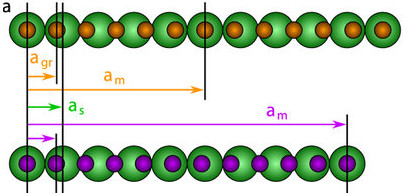A collaboration with Institut Néel (Grenoble)
The exotic electronic properties of pristine graphene are often altered when graphene is supported by a substrate. Indeed, due
to the structural mismatch between graphene and its support, graphene has periodically varying stacking configurations with its substrate. This effect
modulates the graphene-substrate interaction and distance, over a so-called moiré periodicity, which can range from ~1 to ~15 nm.
 The usual structural model used to describe moirés assumes
(Figure on the right top) that a single moiré beating occurs within a moiré period and that the graphene
and moiré lattices are commensurate (integer multiples of their lattice parameters can be found which are equal). Unfortunately, this simple model fails to explain
some experimental observation and more elaborate models have been developed. Some simply assume that the graphene and moiré lattices are incommensurate. Others assume commensurability,
yet without the constraint of a single moiré beating within the moiré unit cell (right figure bottom).
The usual structural model used to describe moirés assumes
(Figure on the right top) that a single moiré beating occurs within a moiré period and that the graphene
and moiré lattices are commensurate (integer multiples of their lattice parameters can be found which are equal). Unfortunately, this simple model fails to explain
some experimental observation and more elaborate models have been developed. Some simply assume that the graphene and moiré lattices are incommensurate. Others assume commensurability,
yet without the constraint of a single moiré beating within the moiré unit cell (right figure bottom).
There are many ways the above assumption for commensurability can be fulfilled, as can be shown by considering strains and rotation of the graphene with respect to its
substrate. Despite previous efforts, a comprehensive description of those effects was lacking. We have provided a fully-consistent description of the full complexity of commensurate
moiré superlattices, relating the graphene, substrate, and moiré, for the general case of an arbitrary strain (including shear, uniaxial, biaxial) and of superlattices having any
number of beatings. We have used this new description to to revisit previously published analysis of experimental observations. We have shown that supported graphene is subjected to strain
levels far below what is usually assumed.
More info in A. Artaud
et al Sci. Rep 6 25670 (2016).